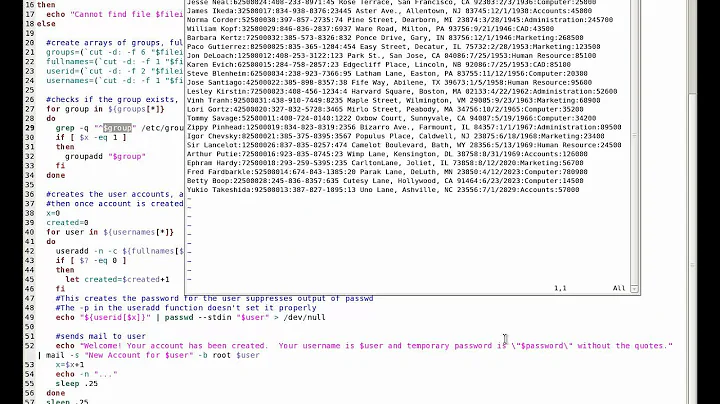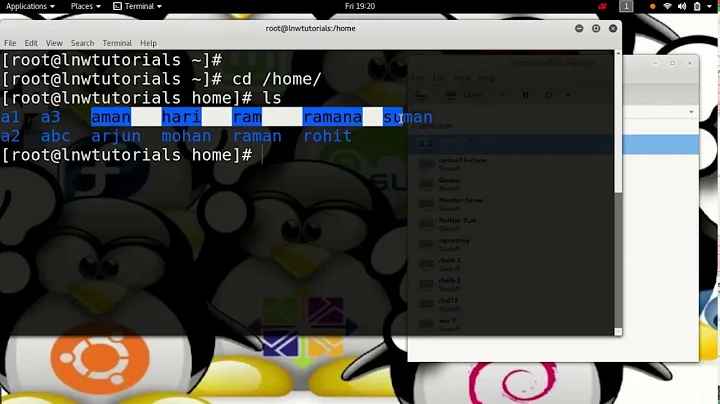Proper way to add a user account via bash script
Solution 1
My solution was provided here: https://unix.stackexchange.com/questions/82923/proper-way-to-add-a-user-account-via-bash-script
by Ulrich Schwarz and Joseph R.. The main thing I had to do was add -s /bin/bash to my existing useradd command and remove -p password which expects an encrypted password.
sudo su -c "useradd mynewuser -s /bin/bash -m -g $PRIMARYGRP -G $MYGROUP"
Then do this:
sudo chpasswd << 'END'
mynewuser:password
END
Solution 2
This will work.
sudo adduser myuser --gecos "First Last,RoomNumber,WorkPhone,HomePhone" --disabled-password
echo "myuser:password" | sudo chpasswd
Solution 3
my script which automatically constructs a service account with ssh key login and no password
#add service group/user
addgroup service-runner
useradd devops-service --create-home --shell /bin/bash --groups service-runner
#gpasswd -a devops-service sudo #allowing sudo requires password, and not a good idea for a service account.
mkdir /home/devops-service/.ssh
chmod 700 /home/devops-service/.ssh
cat [email protected] >> /home/devops-service/.ssh/authorized_keys
chown devops-service:devops-service /home/devops-service -R
Related videos on Youtube
MountainX
You may be interested in the story of SE moderator Monica Cellio and how she was unfairly treated by the corporate management of this site. More info here. An update is available. Let's hope we can cultivate a more fair environment for content creators and moderators going forward.
Updated on September 18, 2022Comments
-
 MountainX over 1 year
MountainX over 1 yearHere's the script code I'm using now:
getent group $MYGROUP if [ $? -ne 0 ] ; then sudo su -c "groupadd $MYGROUP" fi sudo su -c "useradd mynewuser -p mypassword -m -g $PRIMARYGRP -G $MYGROUP"This approach works well on openSuse. But there are several problems with the user account it creates on Ubuntu so I am seeking help here.
- the terminal prompt isn't set (
echo $PS1returns nothing) - the arrow keys and tab key do not work correctly in the terminal
- the password doesn't seem to work (although I'm still unclear exactly what this issue is)
- the /etc/sudoers rights set for this new user are not honored
If instead I manually create the user with
adduser(instead of useradd) I don't have these problems on Ubuntu. But I can't useadduseron openSuse (afaik). Therefore, I need a non-Debian-exclusive script or method of adding user accounts via my bash script that works on Ubuntu (and doesn't stop working on other distros).Finally, I would like to understand the differences between
adduseranduseradd. For example, I want to know which skeleton directory is used byadduseras that might be the reasonuseraddisn't working as expected (because I just accepted the default).Thanks
-
guntbert almost 11 yearsAs for the difference: from the useradd man page (
man useradd): useradd is a low level utility for adding users. On Debian, administrators should usually use adduser(8) instead. -
enzotib almost 11 yearsAlso,
sudo su -c "cmd arg1 arg2"is equivalent tosudo cmd arg1 arg2. -
 MountainX almost 11 years@enzotib thanks. Good to know those are equivalent on Ubuntu because they are not on openSuse. Therefore, I will keep using
MountainX almost 11 years@enzotib thanks. Good to know those are equivalent on Ubuntu because they are not on openSuse. Therefore, I will keep usingsudo su -c "cmd arg1 arg2"so that it works everywhere I need it to work. -
enzotib almost 11 years
adduseris a perl script more than 1000 lines long, so for the differences you can take a look at the script. -
 MountainX almost 11 years@enzotib Yes, I've been reading
MountainX almost 11 years@enzotib Yes, I've been readingadduserbut I don't know perl. So that's not a good approach for me. -
enzotib almost 11 yearsLet me doubt that
sudoandsuwork differently on OpenSUSE from their standard. -
 MountainX almost 11 years@enzotib - please educate me then. I'm slightly confused on this issue.
MountainX almost 11 years@enzotib - please educate me then. I'm slightly confused on this issue. -
h3. almost 11 yearsNow that you've clarified that you're only trying to fix an issue on Ubuntu, the question is on-topic (but marginal). However, you should not post the same question on multiple sites. Your U&L question has been answered, so I'm voting to close here.
-
 MountainX almost 11 yearsHow do I close it myself?
MountainX almost 11 yearsHow do I close it myself? -
geirha almost 11 yearsHave you considered using newusers?
-
 MountainX almost 11 years@geirha, yes,
MountainX almost 11 years@geirha, yes,newuserswould be an option, but this is working for me: unix.stackexchange.com/questions/82923/…
- the terminal prompt isn't set (
-
JasonS about 9 yearsfyi, after using my script, I see that "sudo" is pretty much useless with the service account, as no password means it can not use sudo. You can configure it to allow no-password sudo via visudo but I don't know how to automate that in a script. Also, probably a service account with no-password sudo isn't a good (security) idea.
-
 David Foerster over 7 yearsWhy not simply test the existence of
David Foerster over 7 yearsWhy not simply test the existence ofadduserwithif command -v adduser >/dev/null; thenor the likes? That's the only thing that matters and not the underlying distributions. Also, there are other distributions besides Debian/Ubuntu and OpenSUSE.




